Enrichment Unlocks a Combined Data Set in Real Time
Data enrichment augments in-app, event-level data with additional context and metadata from backend systems like identity and customer relationship management (CRM) systems, content management service (CMS), electronic programming guide (EPG) data, and ad manager reports (e.g. Google Ad Manager) so that your data is unified into a real time, allowing for comprehensive reflection of user interactions, content consumption, and advertising performance – all without labor-intensive data post-processing.
- Home
- Enrich
01
Enrichment can save hours of time spent combining data sources once received. By using this feature, you can get a ready-to-use dataset streamed to the tools you already used.
The Unique Advantages of Data Enrichment

Real-Time Personalization
Drive deeper engagement and loyalty by analyzing up-to-the-moment user interactions. Tailor content recommendations, navigation paths and user messaging based on a user’s immediate behaviors and preferences.

Eliminate Post-Processing
With real-time, enriched data instantly available for analysis, content publishers can bypass the need to wait for post-processing tasks in order to get unified and reconciled data from disparate datasets.

Rapidly Detect and Investigate Issues
Promptly identify and resolve issues that impact viewer experience with a full view context across app and backend system data and the ability to drill down as much as needed.

High Frequency Ad Revenue Optimization
Make high value audience segments available in real time based on a user’s in-the-moment state of mind as reflected by their most recent content and ad engagement. Drive ad revenue by maximizing the impact of every ad impression.
02
There are many use cases for enrichment, all of which provide tangible business benefits
Enrichment Example: CPM

Enrichment Explained
To enrich a stream, using this example, we are modifying the JSON structure of events as they pass through our data pipeline. In doing so we apply rules which append additional information to specified datapoints from a hosted data set in real-time. For Google Ad Manager, that means querying a report and using fields from that report to enrich certain ad events. This avoids having to do table merging and post-processing of data at the endpoint. The result is a more comprehensive view, when visualizing, but provided much quicker.

